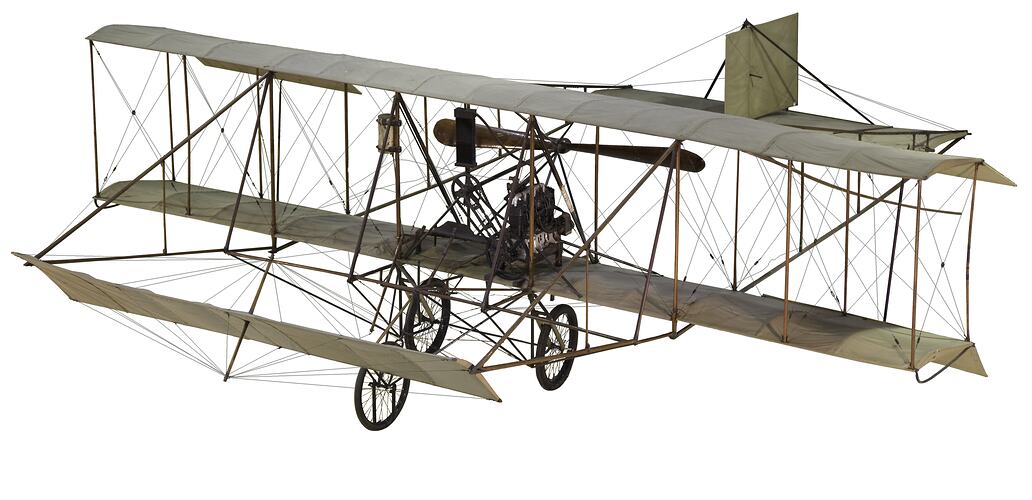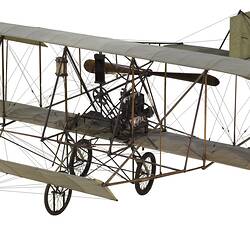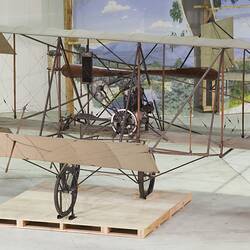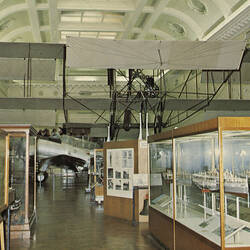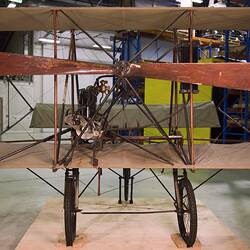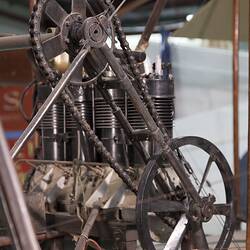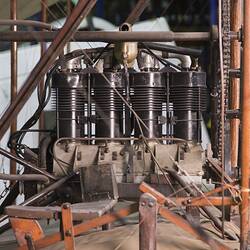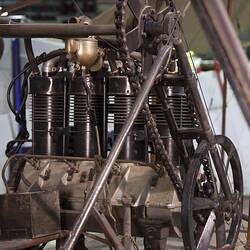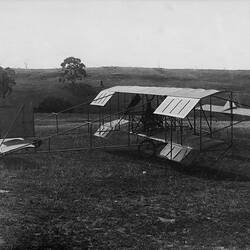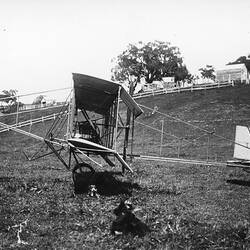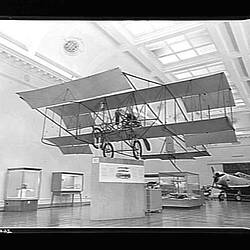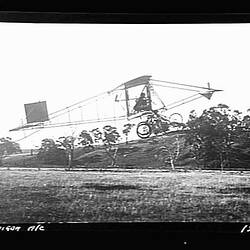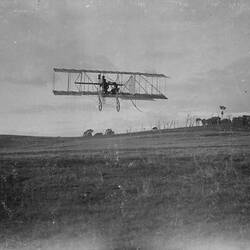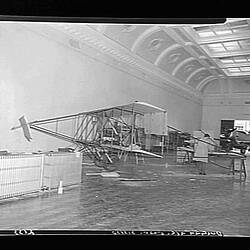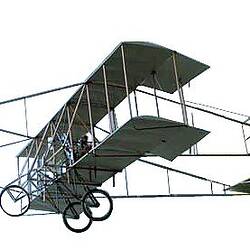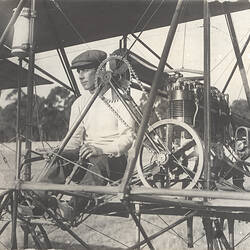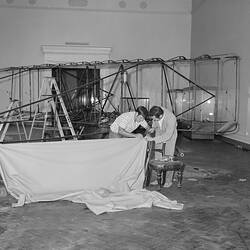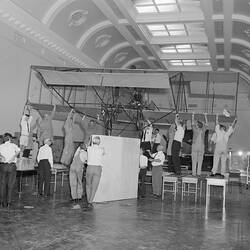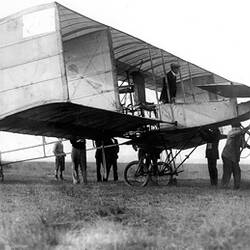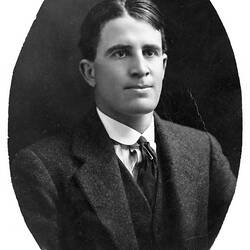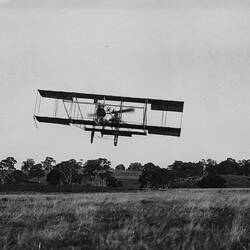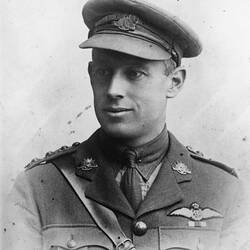Summary
Aeroplane built at Mia Mia, Victoria, by John Robertson Duigan, 1909-1910.
It is a pusher type single-seat biplane with a moving foreplane elevator and lightweight undercarriage. Constructed of wood, metal and rubber coated cotton fabric, made by the Dunlop Pneumatic Rubber Co. since replaced. Fitted with a 25 horsepower (19 kW) vertical four-cylinder, four-stroke, water-cooled petrol engine made by J. E. Tilley, Melbourne. Bore & stroke: 93 x 108 mm; engine weight: 63 kg. The engine is coupled by on open chain drive to a 4-lamination white pine propeller of 2.6 m diameter, with a 3 m pitch mounted behind the pilot's position facing rearwards.
Recognised as the first Australian designed and built aeroplane to successfully achieve controlled, powered flight.
Duigan was born at Terang, Victoria, on 31 May 1882, and studied electrical and motor engineering in London, before returning to join his younger brother, Reginald at the family property 'Spring Plains' at Mia Mia, in central Victoria.
Inspired by the many flights of Wilbur Wright in France in 1908, Duigan built a Wright-type glider from a postcard photograph sent by a friend in Britain in late 1908 and managed to fly it in a strong wind tethered to 110 metres of fencing wire. Following this success, Duigan began work on a powered aircraft, which he first flew on 16 July 1910 but he considered his first true controlled flight occurred on 7 October 1910. Further modifications and improvements were made until he managed sustained flights of up to a kilometre at heights of 30 metres. In January 1911, Duigan demonstrated his plane to newspaper reporters, and on 3 May 1911 he made several public flights before a crowd of 1,000 at the Bendigo Racecourse following a previous demonstration hop at the April Bendigo Easter Fair. Duigan's achievement is all the more remarkable for the fact that he had never seen or flown an aircraft previously and had little technical information with which to work. His first design was based on little more than a postcard of the Wright Flyer, and theory drawn from Sir Hiram Maxim's 1908 book 'Artificial and Natural Flight' supplemented by information from subscriptions to British aviation journals. With the exception of the engine, parts of the undercarriage and the propeller (made by John Fulton, a Carlton patternmaker), each component was made by Duigan and his brother Reginald in a rudimentary workshop at 'Spring Plains'.
Physical Description
Specifications: Length Overall: 30 ft 5 in (9.27 m) - excluding tail skid; 33 ft 3 in (10.12 m) including tail skid Wingspan: 24 ft 6 in (7.47 m) Wing Chord: 3 ft 6 in (1.07 m) Front Elevator: 12 ft x 2 ft 6 in (3.66 m x 0.76 m) Rear Elevator: 12 ft x 3 ft 6 in (3.66 m x 1.07 m) Rudder: 3 ft 6 in x 3 ft high (1.07 m x 0.91 m) Propeller Diameter: 8 ft 8 in (2.64 m) Propeller Pitch: 10 ft (3.05 m) Propeller Speed: 700-800 r.p.m. (at full engine power) Engine Type: vertical in-line four-cylinder, four-stroke, overhead valve, water-cooled petrol engine Bore x Stroke: 93 x 108 mm Engine Power: 25 horsepower @ 1,800 r.p.m. (19 kW) Engine-Propeller Drive Sprocket Ratio: 18 teeth to 42 teeth Engine Weight (including cooling water): 165 lbs (75 kg) Fuel Tank Capacity: 1 gallon (4.5 litres) Oil Tank Capacity: 1 quart (0.95 litres) Take-off Weight Loaded (incl 10 stone pilot): 620 lb (281 kg) Wing Loading: 3 lb per sq ft Power/Weight Ratio: 25.2 lb per horsepower Maximum Air Speed: 40 m.p.h. Take-off Distance: 100 yards in 4 m.p.h. wind
More Information
-
Collection Names
-
Collecting Areas
-
Acquisition Information
Donation from Mr John R. Duigan, 06 May 1920
-
Designer
Mr John R. Duigan, Mia Mia, Victoria, Australia, 1909-1910
Designer & Builder of Airframe. -
Manufacturer of Component
J.E. Tilley & Co. Pty Ltd, Little Latrobe Street, Melbourne, Greater Melbourne, Victoria, Australia, circa 1910
Engine Builder -
Classification
-
Category
-
Discipline
-
Type of item
-
Overall Dimensions
1100 cm (Length), 730 cm (Width), 295 cm (Height)
Estimated overall dimensions from drawings on file. Note it is unclear whether wingspan is 24'6" or 24'0", and whether overall length quoted here includes the rear skid. MSC
-
Exhibition Collection Management
7000 mm (Length), 7435 mm (Width), 2525 mm (Height)
-
Approximate Dimensions
1160 cm (Length), 730 cm (Width), 286 kg (Weight)
Approx dimensions only.
-
Other Dimensions
11.6 m (Length), 7.3 m (Width)
Measurement From Conservation. 63? kg weight (info. from muscat catalogue record)
-
References
[Book] Crotty, David. 2010. A Flying Life: John Duigan & the First Australian Aeroplane. 170.
-
Keywords
Aeronautics, Aeroplanes, Aviation Pioneers, Innovation & Design
